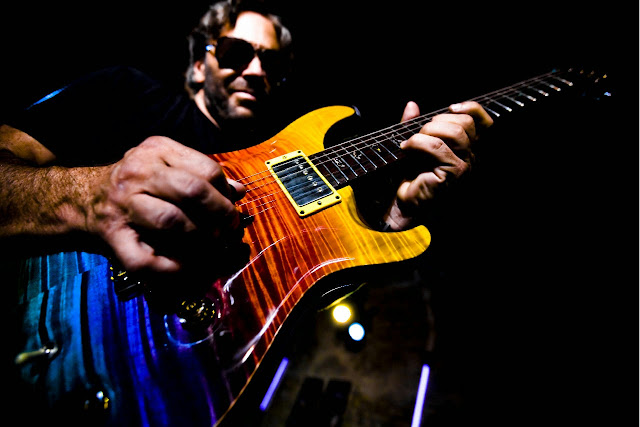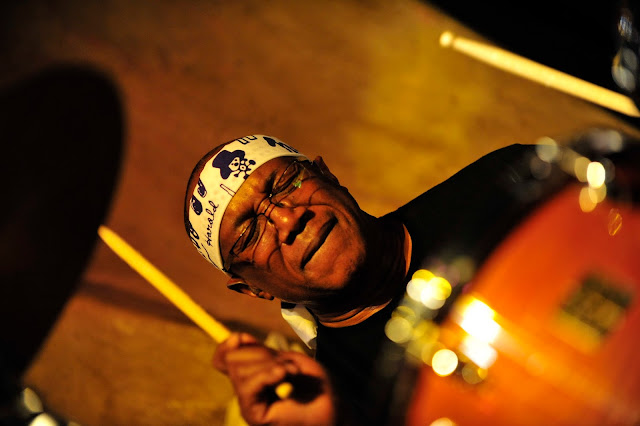 |
| John McLaughlin |
He’s probably the greatest musician-to date. One of fusion's most virtuosic guitar soloists, John McLaughlin placed his blazing speed in the service of a searching spiritual passion that has kept his music evolving and open to new influences. Whether shredding on electric or simmering quietly on acoustic, McLaughlin's intensity and underappreciated versatility have nearly always kept his playing vital, and his best moments -- whether as a solo artist or band member -- represent some of fusion's greatest recordings.
McLaughlin was born January 4, 1942, in Yorkshire, England, and began playing guitar at age 11. Initially attracted to blues and swing, he worked with British artists like Georgie Fame, Graham Bond, Brian Auger, and Ginger Baker. McLaughlin formed his own band in 1968, and recorded the excellent debut Extrapolation in early 1969. Later that year he moved to New York to join Tony Williams' groundbreaking fusion band Lifetime, and appeared on the classic Emergency! Through Williams, McLaughlin was invited to join Miles Davis' band, and became an important part of fusion landmarks like In a Silent Way, Bitches Brew, and A Tribute to Jack Johnson. In 1970, wanting to explore acoustic and Eastern music, McLaughlin recorded the classic My Goal's Beyond; he soon left Davis, and after one further solo album, Devotion, McLaughlin spent some time woodshedding.
He re-emerged in 1971 as leader of the Mahavishnu Orchestra, a seminal band that did much to define and popularize early jazz-rock fusion, as evidenced by the albums The Inner Mounting Flame, Birds of Fire, and Visions of the Emerald Beyond. Pausing to record Love Devotion Surrender with Carlos Santana in 1972, McLaughlin led Mahavishnu until 1975. Returning to spiritual preoccupations on My Goal's Beyond, he then formed Shakti, which fused acoustic jazz with Indian music over the course of three albums. McLaughlin returned to his solo career in the late '70s, forming a backing outfit called the One Truth Band, and also recording the guitar trio albums Friday Night in San Francisco and Passion, Grace & Fire with fellow fusion burner Al di Meola and flamenco guitarist Paco de Lucia. As the '80s went along, McLaughlin experimented with classical-jazz hybrid composing; there was also a short-lived Mahavishnu reunion in the mid-'80s.
In the 1990s McLaughlin continued to record steadily in both electric and acoustic groups. He signed to Verve, where he would remain for 13 years. Some of the more notable albums from that period include the acoustic Time Remembered: John McLaughlin Plays Bill Evans in 1993; After the Rain with Elvin Jones and Joey DeFrancesco in 1995; and 1996's The Promise, which featured the guitarist in a number of settings, including a reunion with his acoustic trio partners di Meola and de Lucia, and a trio with DeFrancesco and drummer Dennis Chambers. The drummer was also a part of McLaughlin's final album of the decade, Heart of Things, a furious bout of electric jazz.
The 21st century found McLaughlin in another nostalgic mood, releasing Remember Shakti: The Believer, a live set featuring the guitarist (playing electric guitar) with electric mandolinist U. Shrinivas, kanjira and ghatam player V. Selvaganesh, and legendary tabla player Zakir Hussain. While it wasn't a Shakti album proper, it nonetheless echoed that group's intricate and amazing rhythmic and harmonic breakthroughs. The group toured and released Saturday Night in Bombay a year later. McLaughlin's Euro-classical-leaning Thieves and Poets appeared in 2003. In 2004, WEA in Germany issued the massive 17-CD box set of McLaughlin's Montreux Concerts, which featured performances recorded between 1974 and 1996. Industrial Zen, released in 2006, was a mixed-bag recording where the guitarist's ambitions ran wild. It was his final album for Verve.
 |
| John McLaughlin |
In 2008 McLaughlin issued Floating Point, an extension of many of the concepts on Industrial Zen, on the Abstract Logix imprint. The final track on that album was entitled "Five Peace Band"; it served as the name for a super group assembled by McLaughlin and Chick Corea for a one-off world tour. The other members were saxophonist Kenny Garrett, drummer Vinnie Colaiuta, and bassist Christian McBride; an album of the same name was released in 2009 on Concord. To the One, a studio album with his 4th Dimension band was released on Abstract Logix in the spring of 2010. McLaughlin resurfaced two years later with Now Here This, featuring new 4th Dimension drummer, Ranjit Barot.
"I'm a guitar player that's what I am primarily, that's what I'll always be," McLaughlin has been quoted as saying. "(And) I'm an eternal learner. I don't want to stop learning because I feel that no matter what I've done, I'm really just beginning again. I don't think I'll ever stop learning."





































